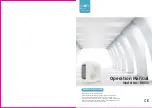
3 Installation
Installation manual
6
AZQS100~14 AZQS100~140B7Y1B
Split system air conditioners
4P3855281 – 2014.08
3.2.2
To determine if oil traps are required
If oil flows back into the outdoor unit's compressor, this might cause
liquid compression or deterioration of oil return. Oil traps in the rising
gas piping can prevent this.
If
Then
The indoor unit is installed
higher than the outdoor
unit
Install an oil trap every 10 m (height
difference).
a
b
10 m
a
Rising gas piping with oil trap
b
Liquid piping
The outdoor unit is
installed higher than the
indoor unit
Oil traps are NOT required.
3.3
Checking the refrigerant piping
3.3.1
Checking refrigerant piping: Setup
a
c
f
b
d
e
R410A
a
Pressure gauge
b
Nitrogen
c
Refrigerant
d
Weighing machine
e
Vacuum pump
f
Stop valve
3.3.2
To check for leaks
NOTICE
Do NOT exceed the unit's maximum working pressure (see
"PS High" on the unit name plate).
NOTICE
Make sure to use a recommended bubble test solution
from your wholesaler. Do not use soap water, which may
cause cracking of flare nuts (soap water may contain salt,
which absorbs moisture that will freeze when the piping
gets cold), and/or lead to corrosion of flared joints (soap
water may contain ammonia which causes a corrosive
effect between the brass flare nut and the copper flare.
1
Charge the system with nitrogen gas up to a gauge pressure of
at least 200 kPa (2 bar). It is recommended to pressurize to
3000 kPa (30 bar) in order to detect small leaks.
2
Check for leaks by applying the bubble test solution to all
connections.
3
Discharge all nitrogen gas.
3.3.3
To perform vacuum drying
1
Vacuum the system until the pressure on the manifold indicates
−0.1 MPa (−1 bar).
2
Leave as is for 45 minutes and check the pressure:
If the pressure…
Then…
Does not change
There is no moisture in the
system. This procedure is
finished.
Increases
There is moisture in the
system. Go to the next step.
3
Evacuate for at least 2 hours to a pressure on the manifold of
−0.1 MPa (−1 bar).
4
After turning OFF the pump, check the pressure for at least
1 hour.
5
If you do NOT reach the target vacuum or cannot maintain the
vacuum for 1 hour, do the following:
▪ Check for leaks again.
▪ Perform vacuum drying again.
NOTICE
Make sure to open the stop valves after installing the
refrigerant piping and performing vacuum drying. Running
the system with the stop valves closed may break the
compressor.
3.4
Charging refrigerant
3.4.1
To determine the additional refrigerant
amount
To determine if adding additional refrigerant is necessary
If
Then
L1≤30 m (chargeless length)
You do not have to add
additional refrigerant.
L1>30 m
You must add additional
refrigerant.
For future servicing, encircle the
selected amount in the tables
below.
INFORMATION
Piping length is the one way length of liquid piping.
To determine the additional refrigerant amount (R in kg)
L1 (m)
30~40 m
40~50 m
R:
0.5 kg
1.0 kg
3.4.2
To determine the complete recharge
amount
Model
L1 (m)
5~10
10~20
20~30
30~40
40~50
125
1.9
2.4
2.9
3.4
3.9
AZQS140
3.0
3.5
4.0
4.5
5.0






























